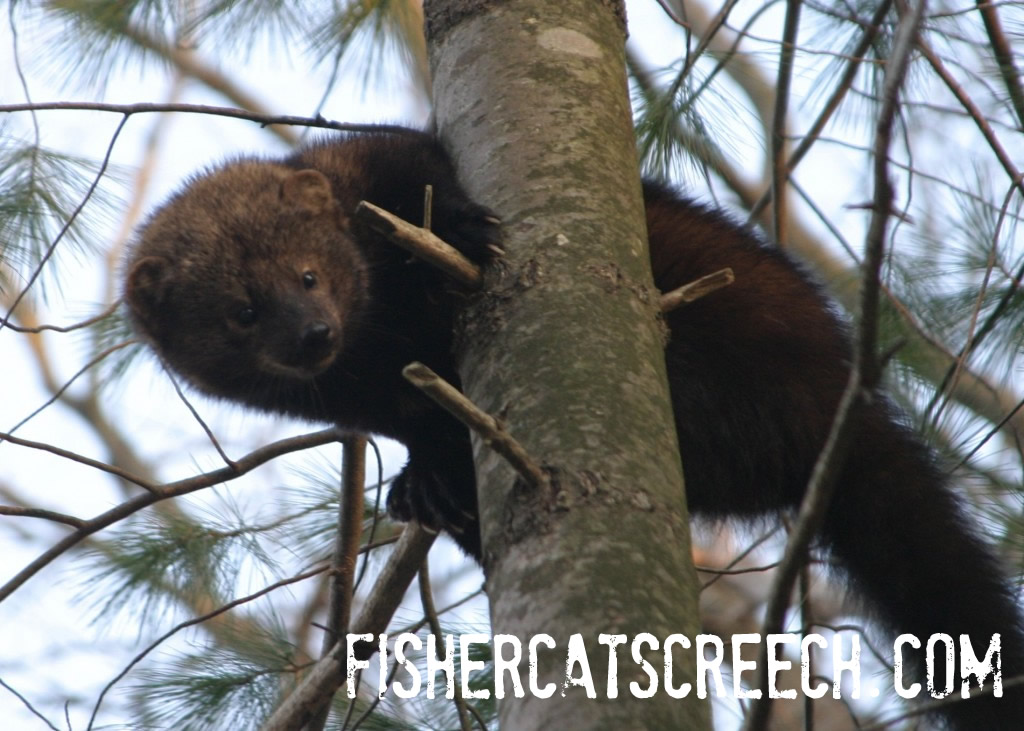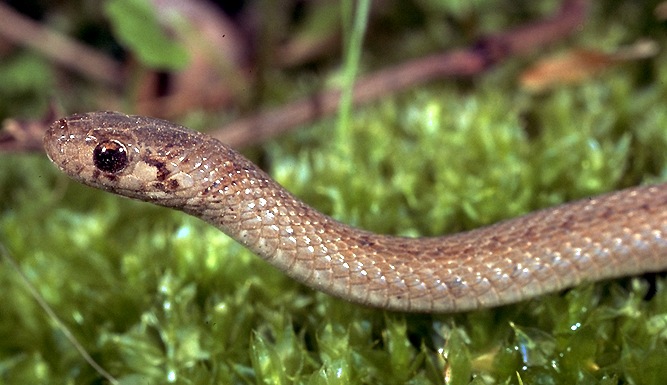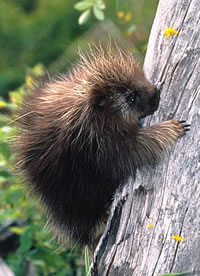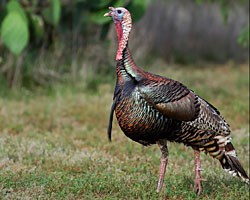Wildlife is a term that traditionally refers to non-domesticated vertebrates, but has come into more general usage to refer to all wild plants, animals and other organisms . In our site, there is an abundance of wildlife and there is proof of it wherever you look. Below are ten species that you may encounter while wandering the northern edge of Niquette Bay State Park and specifically within site 6. Wildlife is a large part of why people love to be outdoors so while you are exploring keep your eyes, ears and even your nose on high alert for signs of the life surrounding you.
For a complete list of possible wildlife that could possibly be found within our hectare click the tab to the right titled "species list" on the top of the page.
Barred Owl:
 |
| Barred Owl |
The barred Owl is a large owl of extensive woodlands and
is found in Niquette Bay State Park. On our second visit we heard the well recognized call (who
who who who, who who who who-aahh). Its habitat is generally forested areas,
from swamps and riparian areas to uplands and it prefers large blocks of
forest. The barred owls main prey include small mammals, rabbits, birds,
amphibians, reptiles, and invertebrates. It is mostly found nesting in cavities
in deciduous trees or uses open nest made by a hawk or crow. Barred Owls
typically hunt at night or at dusk by sitting on a high perch and looking and
listening for prey, which they catch within a short flight. Barred Owls have
known to be aggressive, flying at and fighting rivals at the edges of their
territory. There are cavities within our site that are large enough to house a barred owl nest.
Fisher:
 |
| Fisher |
Fishers have long, slender bodies with muscular, short legs similar to
their relatives-weasel, mink, marten, and otter. Their thick, grayish-brown to
brownish-black glossy fur tends to be darker on females. White-tipped hairs on
older fisher give a grizzled appearance. Fisher have strong claws for climbing
and a long, bushy, black, tapered tail. Fisher, although carnivorous, generally
eat whatever comes along. Their main prey include snowshoe hare, porcupine,
small mammals (mice, voles, shrews, moles) , and squirrels (gray, red, and
flying squirrels). They also feed on birds, amphibians, insects, fruits, nuts,
and carrion. They help keep mice and vole numbers under control. Fisher kill
porcupines by repeated swift attacks to the face and head. After killing the
porcupine, the fisher flips it over on its back and starts eating the belly.
Fishers are solitary except during the mating season. Fisher travel along
ridges, crossing stream valleys to reach the next ridge. Fisher occupy mature softwood,
mixed hardwood-softwood, and forested wetlands. The amount of structural
diversity is likely more important as habitat criteria than the tree species
and forest types. Fisher use hollow trees and logs, rocky outcrops, old
porcupine dens, root masses, and brush piles as den sites and hunting areas.
They'll tear apart decaying snags in search of their prey. To keep warm during
cold spells they seek shelter in these temporary dens or under the snow. There is plenty of habitat for Fisher to live in within our hectare.
Emerald Ash Borer:
 |
| Emerald Ash Borer |
The Emerald
Ash Borer is an invasive beetle from Asia. First discovered in the United
States and Canada just over 10 years ago it’s a relatively new invasive
species. It was first discovered
in the northern Midwest (Michigan to be exact) and has spread east. This is a
major problem because the beetle infests and kills the North American ash
species including the green, white, black, and blue ash. These beetles leave a
distinctive D-shaped exit hole in the outer bark of the branches and trunk. The larvae feed in the cambium between the bark and wood,
producing S-shaped galleries that girdle and kill branches and trees. Ash is
one of the ten most common trees in Vermont, so this insect will have a major
impact if it becomes established in Vermont. As of now, VT is free of the
invasive species although we need to continue to be highly careful as it has
been found just north of our border in Carigan, Quebec.
Brown Snake:
 |
| Brown Snake |
Brown snakes can be found in overgrown wet
meadows and rocky woods at low elevations. Out of all of Vermont, it is most often
seen in the Lake Champlain basin. Within their
range, they are a very commonly found species of snake. . They are most
frequently found under leaf litter or debris piles. Most brown snakes eat a
variety of small insect, invertebrates, amphibians, and other small animals.
They consume a variety of prey, including, worms, snails and slugs, while
salamanders are also high on their list.
Scarlet Tanager:
 |
| Scarlet Tanager |
The Scarlet Tanager is a striking black-winged red bird
and is a common species of the eastern forest interior. Even with its beautiful
coloring, it is often overlooked because it tends to be difficult to spot and
it prefers the forest canopy. It is considered a medium-sized songbird. It
breeds in deciduous and mixed deciduous/coniferous woodlands, especially mature
forests. It is occasionally found in suburban areas with large trees, and it
winters in montane evergreen forests. This Tanagers main prey includes insects
and spiders, some earthworms, buds, and fruits. It captures insects by flying
and grabbing them while hovering. It has known to beat prey against branch to
kill it. It’s nest is flimsy- usually a shallow open cup of twigs, grasses,
bark strips, and rootlets, lined with grass and is placed among a cluster of
leaves in a deciduous tree.
Chestnut-sided Warbler:
 |
| Chestnut-sided Warbler |
It is a common bird of second growth and scrubby forests, and
is distinctive in appearance. No other warbler combines a greenish-yellow cap,
a white breast, and reddish streaks down the sides. This warbler breeds in early
successional deciduous woods and winters in moist tropical forest. Preys mostly
on insects and other arthropods, and occasionally fruit. It nest’s an open cup
woven of bark strips, weed stems, grasses, and plant down. Lined with fine
grasses, hair or rootlets.
Porcupine:
 |
| Porcupine |
The porcupine is a rodent. It has
black to brownish-yellow fur and strong, short legs. It has hairless soles on
its feet that help it climb trees. It has a round body, small ears and a small
head. The most recognizable feature of the porcupine is its quills. A porcupine
may have as many as 30,000 quills. The common porcupine is a solitary animal,
although it may den with other porcupines in the winter. It makes its den in
caves, decaying logs and hollow trees. The common porcupine doesn't hibernate,
but it may stay in its den during bad weather. The common porcupine is a good
swimmer, its hollow quills help keep it afloat. It is also an excellent
tree-climber and spends much of its time in trees. Porcupines mate in late summer
and early fall. The common porcupine is a herbabore. It eats leaves, twigs and
green plants like skunk cabbage and clover. In the winter, it may eat bark. It
often climbs trees to find food. It is mostly nocturnal, but will sometimes
forage for food in the day.
Wild Turkey:
 |
| Wild Turkey |
Wild
Turkeys live in open woodlands and forests
with lots of clearings and meadows.
They travel during the day looking for food. They eat a great variety of foods, including:
insects, spiders, snails, slugs, salamanders, small lizards, small frogs,
millipedes, grasshoppers, very small snakes, worms, grasses, vines, flowers, acorns,
buds, seeds, fruits, clovers, dogwood, blueberries, cherries, hickory nuts,
beechnuts, and other vegetation. Turkeys travel in small flocks.
Wild Turkeys have good eyesight and hearing, and they are very fast runners.
Their nests are made in the ground and are a shallow depression, lined with
leaves and covered up with vines
and other plants. The female will sit on the eggs for roughly a month. This
makes her very vulnerable to predators. Wild Turkeys do not hibernate
or fly south, instead, in the winter, they will continue to roam in search of
food. Their diet
changes with the seasons, depending on what foods are available.
White-tailed Deer:
 |
| White-tailed Deer |
The white-tailed deer is tan or
brown in the summer and grayish brown in winter. The white-tailed deer lives in
wooded areas. In some areas, deer overpopulation is a problem. Gray wolves and
mountain lions used to be predators of the white-tailed deer and helped keep
their population under control. But because of hunting and human development,
there are not very many wolves and mountain lions left in some parts of North
America. Sometimes a bobcat or a coyote will kill a young deer, but people and
dogs are now the deer's main predator. Because there are not many natural predators,
deer populations can sometimes grow too large for their environment and deer
can starve to death. When a white-tailed deer is alarmed, it may stomp its
hooves and snort to warn other deer. It may also "flag" or raise its tail and show its white underside. When a
mother deer is running, this white underside can help her fawns follow her.
White-tailed deer are very good runners. They can run at speeds of up to 30
mile an hour. They are also good leapers as well as swimmers. The mother leaves
her fawns well hidden for hours at a time while she feeds. If she has more than
one fawn, she hides them in separate places. While they are waiting for their
mother to return, the fawns lay on the ground with their heads and necks
stretched out flat on the ground. This makes it harder for predators to find
them. Female fawns may stay with their mother for two years; males usually
leave after a year. The white-tailed deer is a plant eater. It follows
well-used trails to its feeding areas. It feeds in the early morning hours and
in the late afternoon n the fall, it eats corn, acorns and other nuts. In the
winter, it eats the buds and twigs of woody plants.
European Earthworm:
 |
| European Earthworm |
Although this is not the most abundant
earthworm, even in its native range, it is a very conspicuous and familiar
earthworm species in garden and agricultural soils of the temperate zone, and
is frequently seen on the surface, unlike most other earthworms. it forms
temporary deep burrows and comes to the surface to feed, as opposed to
burrowing through the soil for its food as most other earthworms do. While they
generally feed on plant material, they have been observed feeding on dead
insects and feces.

To the right is a table based on the presence and absence of key habitat features for wildlife in our hectare. There are certain main factors which species may need to survive or cannot survive in at all which are presented in the table as either present on our Site or absent on our site. By looking at what factors are present or absent, generalizations as to what species may or may not be living there can be made. Another way to look at these factors is the same way that you may look at an 'umbrella species' - as 'umbrella factors' - because the presence of any of the larger factors could indicate a variety of species living in the area. For example the lack of any sort of wetlands on the Site would indicate that there would not be any sort of fish or animal that spends most of it's life in water.

This creative map shows where some of the areas you are most likely going to see some type of wildlife. The blue region indicates rocky outcrops. These are prime habitat for small mammals; anything from chipmunks to fishers. The red shaded region indicates areas with many snags. This provides great habitat for both mammals (such as a Porcupine) and birds (such as the Barred Owl). The areas in green show the low, more reachable vegetation for mammals such as Deer and maybe even a Moose. The black line is the trail that runs through our hectare.







 To the right is a table based on the presence and absence of key habitat features for wildlife in our hectare. There are certain main factors which species may need to survive or cannot survive in at all which are presented in the table as either present on our Site or absent on our site. By looking at what factors are present or absent, generalizations as to what species may or may not be living there can be made. Another way to look at these factors is the same way that you may look at an 'umbrella species' - as 'umbrella factors' - because the presence of any of the larger factors could indicate a variety of species living in the area. For example the lack of any sort of wetlands on the Site would indicate that there would not be any sort of fish or animal that spends most of it's life in water.
To the right is a table based on the presence and absence of key habitat features for wildlife in our hectare. There are certain main factors which species may need to survive or cannot survive in at all which are presented in the table as either present on our Site or absent on our site. By looking at what factors are present or absent, generalizations as to what species may or may not be living there can be made. Another way to look at these factors is the same way that you may look at an 'umbrella species' - as 'umbrella factors' - because the presence of any of the larger factors could indicate a variety of species living in the area. For example the lack of any sort of wetlands on the Site would indicate that there would not be any sort of fish or animal that spends most of it's life in water.
No comments:
Post a Comment